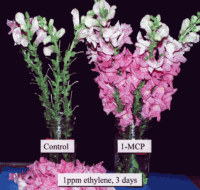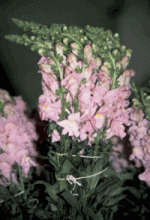Maturity and Quality
For local sales, snapdragons are typically harvested when the flowers on the lower one-half to two-thirds of the spike are open. A less mature stage is desirable for shipping and/or short-term storage. Purchase those cultivars that are less sensitive to ethylene. At least two to five florets per stem should be open. Avoid flowers with excessive stem bending and yellowing foliage, which indicate poor temperature management after harvest.
Grading and Bunching. Snapdragons are bunched in groups of 10 by color. Flowers must have straight stems and reasonably healthy foliage. Foliage on the lower third of the stem should be removed.
Postharvest Handling and Storage
Snapdragons can be stored at 0-1°C for 7 to 10 days if they are wrapped in polyethylene film to retard moisture loss. Snapdragons have been satisfactorily stored for up to 3 weeks at -1°C. For long-term storage, bud-harvested flowers should be used. Bud-harvested flowers are ones in which the bottom two or three florets have colored petals emerging about one-quarter of an inch above the calyx. Snapdragons are relatively sensitive to ethylene gas. Flowers on harvested spikes assume a permanent, upward bend, thus reducing quality, if held at warmer temperatures for even a short time in a non-vertical position. Snapdragons should always be stored and shipped upright in snapdragon hampers at low temperatures. Pretreatment with naphthyphthalamic acid can overcome this bending, but it is not registered for this purpose.
Most snapdragon cultivars are sensitive to ethylene. Older flowers on a stem are more susceptible to ethylene than younger ones. However, some cultivars are naturally ethylene resistant and, therefore, respond little to treatment with 1-MCP or STS.
Pretreatments
Treatment with 1-MCP or pulsing with STS protects snapdragon flowers from ethylene-induced shattering. Snapdragons also benefit from an overnight pulse at 20°C with a preservative fortified with 7% sucrose. Upper flowers on spikes treated in this way open with better color than control flowers. Snapdragons are best stored with only a few flowers open, but this often results in poor development of the flowers on the spike and fading of color at the tip. Spikes cut with only one or two flowers open should be opened in a solution containing 300 ppm 8-hydroxyquinoline citrate (8-HQC) and 1.5% sucrose. This bud-opening solution can also be used as a vase solution. The addition of 25 ppm of the growth regulator n-dimethylamino succinamic acid (Alar, B-nine) increases flower quality and also counteracts the excess spike length that sometimes results from placing snapdragons in 8-HQC and sucrose. Pulse treatments with naphthylpthalamic acid or Ca++ antagonists can reduce geotropic curvature that results from horizontal storage at warmer temperatures.
Packing
Snapdragons are usually packed upright in hampers or Proconas, which reduce the likelihood of geotropic bending. If the flowers are properly pre-cooled and transported at optimal storage temperatures (0-1°C) they can be packed in a normal horizontal flower box.
Special Considerations
Do not remove more leaves than necessary, as this can stimulate flower fall. Do not use any home brews (i.e. anti-freeze) as replacements for preservative solutions. The many pastel flower colors allow florists and consumers innumerable options. The flower can be made to snap shut after separating and releasing the two-lipped corolla (fused petals). When grown as a garden plant, treat them as an annual although many will respond as a perennial, depending on location and cultivar.
Temperature & Controlled Atmosphere Photos
Description
Antirrhinum majus cvs. The many pastel flower colors of the tall spikes of snapdragons allow florists and consumers innumerable design options. Snapdragons used to be considered very sensitive to ethylene, but the newer cultivars have been selected for ethylene resistance, and ethylene normally causes a problem only when present in moderate concentrations. Flower drop (shattering) occurs in 24 hours if ethylene is present in the air at concentrations of 0.5 ppm or more. Antirrhinum is Greek for “like” and “nose” in reference to the flower shape.




